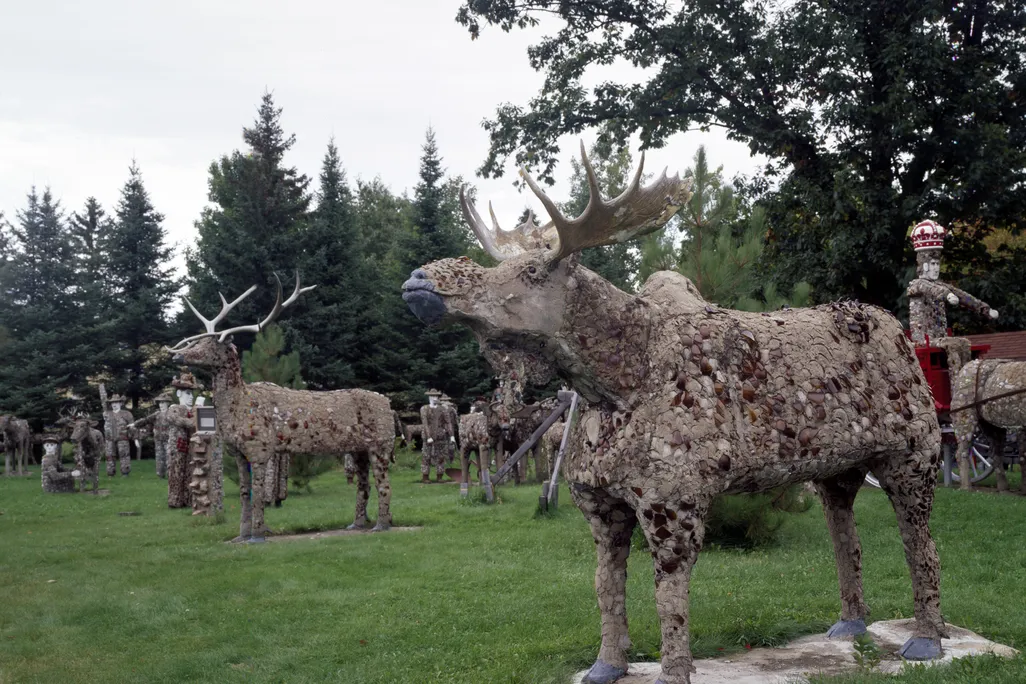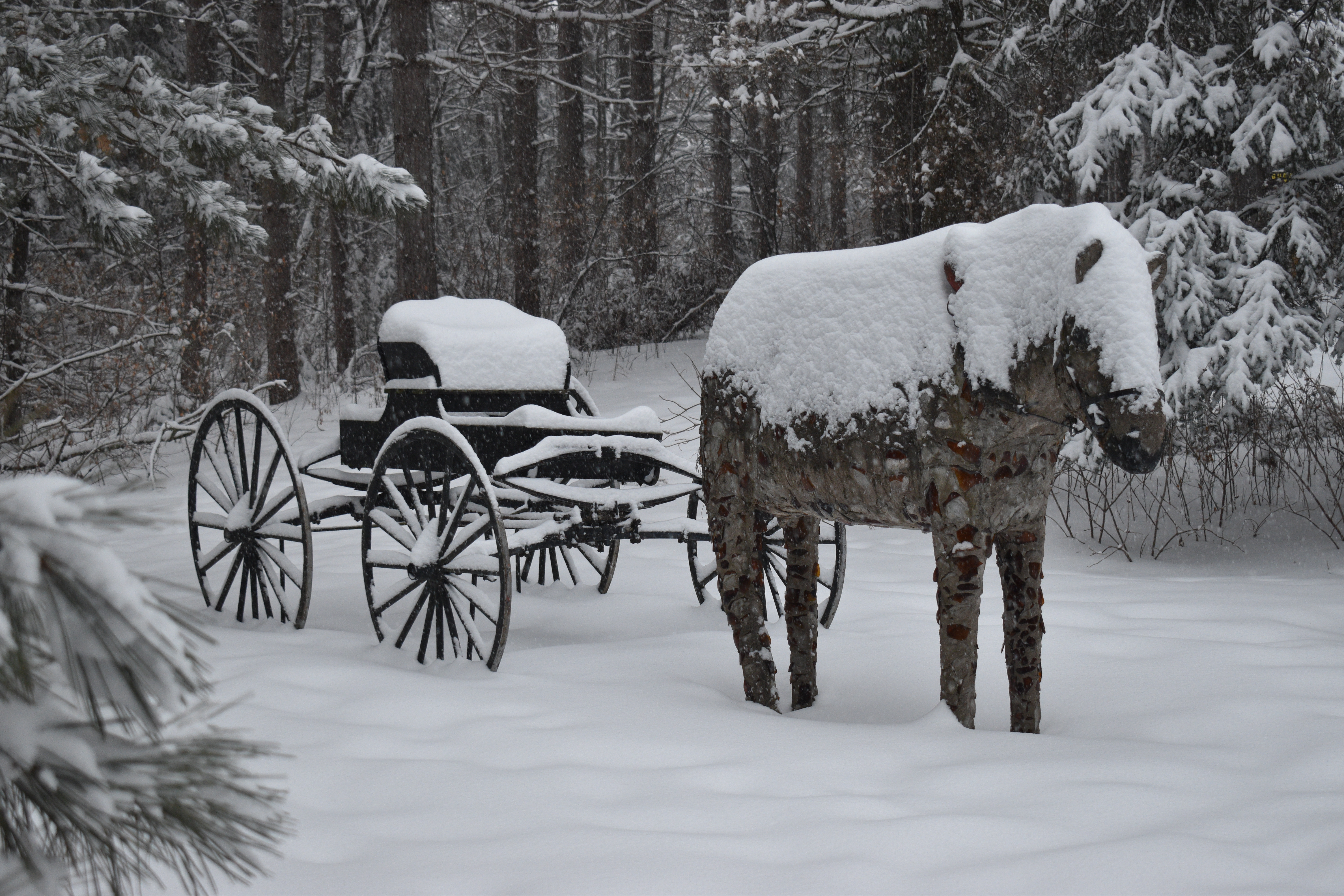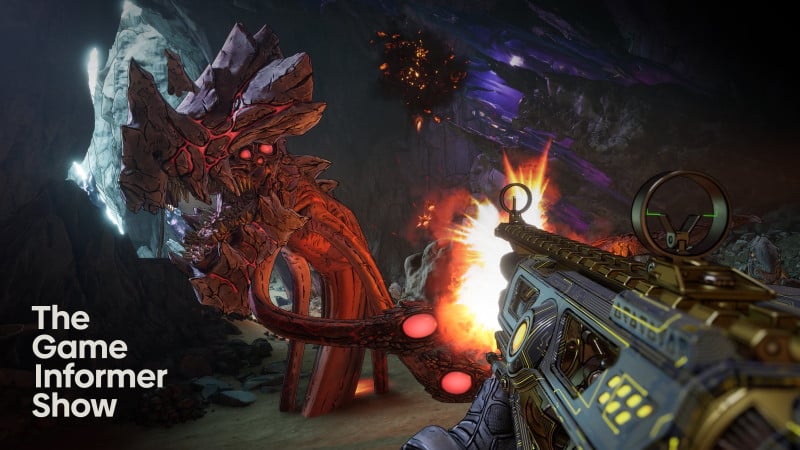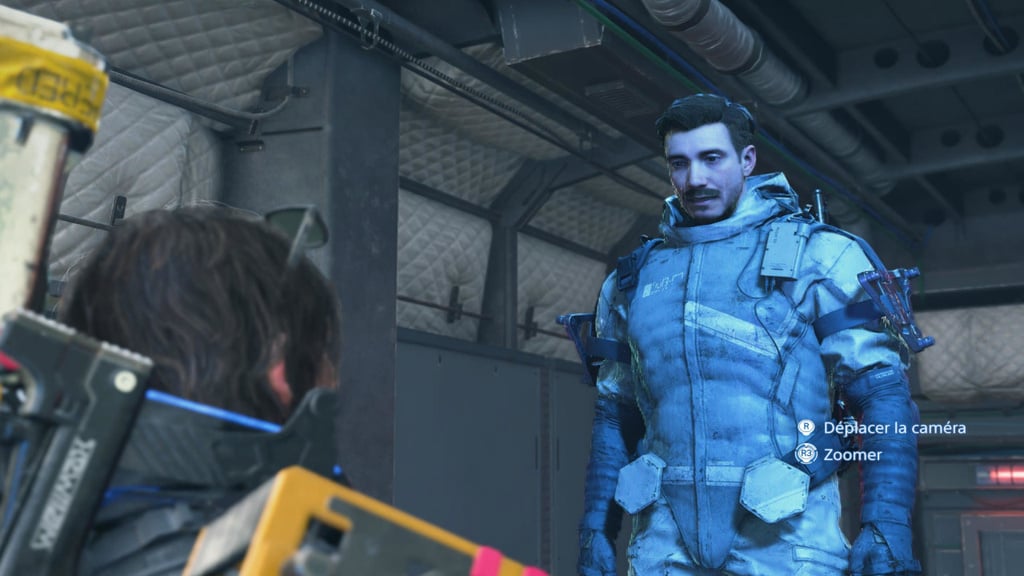A lumberjack created more than 200 sculptures in Wisconsin's Northwoods
When a Lumberjack’s Imagination Ran Wild, He Created More Than 200 Sculptures in Wisconsin’s Northwoods
Decades later, a conservator keeps Fred Smith’s art alive in the whimsical Wisconsin Concrete Park

During Fred Smith’s golden years, art inexplicably began to pour out of him. The retired lumberjack loved to work with his hands, think with his hands, speak with his hands—and one day, like magic, he began to create with his hands.
Bent over by age and arthritis, the Phillips, Wisconsin, resident continued to build life-size and larger-than-life concrete sculptures—over 200 in all—from the late 1940s to the mid-1960s, blending local culture and lore with the wider world and the great beyond.
Smith’s homestead farm soon filled with images from his life and imagination as he depicted everything from everyday folks to folk heroes, as well as symbols of American history, patriotism and spirituality.
The sculptures are loosely organized by theme. Even so, the panorama of animals, humans and objects all seem to mix and mingle in the same landscape, leading to plenty of intriguing juxtapositions. Picture everything from Sacagawea and the Statue of Liberty to a musky so massive it’s pulled by a team of horses.
When asked about his monuments, Smith, who died in 1976 at 89 years old, would simply respond with laughter. “Nobody knows why I made them,” he said. “Not even me.”
/https://tf-cmsv2-smithsonianmag-media.s3.amazonaws.com/filer_public/b9/fd/b9fd9e1d-e9a1-4768-a8aa-c47cf4283e9f/0009-amft-portrait-1024x688.jpg)
Unable to read or write, he taught himself to form these sculptures using wooden structures at their core wrapped in mink or barbed wire, covered in layers of cement, and adorned with broken glass and other found objects.
Today, his eclectic display lives on at the Wisconsin Concrete Park, an outdoor sculpture garden situated within a 16-acre setting in the state’s sparsely populated Northwoods region, where the trees outnumber the people.
What shines through in Smith’s work—nearly half a century after his departure—is a profound reverence for nature and for the many ordinary and extraordinary people, places and events explored throughout his art.
Preservation tools and techniques
Surviving the area’s elements, particularly the long and frigid winters, is easier said than done, though. What visitors may overlook is the painstaking upkeep that goes into these folk art statues that are exposed to Mother Nature’s whims and Father Time’s unrelenting wear and tear.
This past year, for example, a tree branch took Paul Bunyan’s head off, injured his arm and walloped one of his wolfhounds in one fell swoop, says Ann Grzywnowicz, operations manager of the Friends of Fred Smith, a nonprofit formed to preserve the park and develop it into an educational and cultural facility.
Restoring the legendary lumberjack to his former glory will be one of the biggest and most significant projects awaiting Ben Caguioa, a sculpture conservator based in Chicago, when he returns this summer to tackle the most recent round of destruction caused by wind, water and winter.
Need to know: How to visit the Wisconsin Concrete Park
- The Wisconsin Concrete Park is located just south of Phillips, in Price County, Wisconsin.
- The park is open to the public year-round during daylight hours. No admission is required, but donations are encouraged, as the funds go toward preservation work.
His toolbox includes a range of materials—such as marine epoxies, fumed silica and elastomeric caulking—meant to restore structural integrity and aesthetic appeal. This undertaking involves repairing breaks, fixing instabilities, strengthening sculptures or leveling those that have begun to tilt.
Along the way, Caguioa has replaced antlers, reinforced legs and re-leveled the big fish. He has also worked extensively on the lumberjacks near the park entrance, one of which completely collapsed and had to be rebuilt from the ground up.
Many of these sculptures were assembled around wooden two-by-fours, and these box frames—especially within the human figures—gradually decay. The armature that runs up through the legs is made of galvanized pipe that rusts out.
Since there are only two points of contact with the ground, the statues eventually begin to wobble. To reinforce ankles, Caguioa inserts stainless steel rods within the galvanized pipe or replaces that pipe with a steel rod of equivalent thickness.
On breaks and cracks, the conservator uses marine epoxies to establish a solid connection. “I’ll inject that into the cracks using a syringe,” Caguioa says. When he needs to fill a larger gap, he thickens the epoxy with fumed silica to achieve a consistency that resembles a viscous ointment. From there, Caguioa disguises the fractures using elastomeric caulking dusted with sand to replicate the appearance of the original concrete.
If the sculpture spans two or more bases or if the original base is cracked, he’ll use flexible joints to compensate for the movement, much like the expansion joints in sidewalks. To form a flexible adhesion, he uses caulk to fill the gap before dusting the surface. “I’ll match the texture of my surface covers to his by using local sand,” Caguioa notes, so that it has the same coarseness as the sand Smith would have mixed into Portland cement long ago.
Organic elements are especially prone to damage. Antlers on deer and moose sculptures either deteriorate due to moisture ingress or get chewed up by squirrels. Over the years, Caguioa has replaced the headgear on deer with real antlers and the originals mounted on moose with synthetic alternatives.
/https://tf-cmsv2-smithsonianmag-media.s3.amazonaws.com/filer_public/39/54/39540f23-7f34-4fae-84a6-8912ae326d61/damaged_paul_bunyan.jpg)
Some of the organic parts used within the sculptures absorb water and retain that moisture, he says, which leads to expansion and contraction during the freeze-thaw cycle. On the horses, sections of the lower jaw occasionally fall off because the sculptures were shaped around actual horse skulls, and the enlargement of that material will “pop off chunks of concrete,” Caguioa explains.
Once he has handled larger and more serious issues, Caguioa moves on to touch-ups that may be more cosmetic in nature, like re-adhering bottle glass, automotive reflector glass or other surface embellishments using a clear elastic adhesive.
Now in her 70s, Sally McFadyen recalls her childhood days when she observed how Smith, her great-uncle, would pick up these shards of glass with nothing more than his bare hands, callused over from a lifetime of hardscrabble wilderness work and cutting timber using huge hand-operated logging tools. “His hands were so tough,” she says. “It was unbelievable.”
This glass brings motion and vitality to an art form typically thought of as static and unchanging, co-authors Lisa Stone and Jim Zanzi point out in their 1991 book, The Art of Fred Smith. Smith was creative in more ways than one, and the interplay between glass and light reflects his passion for song and dance, which served as a “constant conduit between the artist and the world,” they write. Smith made his first fiddle before he’d hit his teenage years, and late in life, after he began using a wheelchair, he shook to the music playing in his head. In between, while tending bar at his Rock Garden Tavern, he was known to tie sleigh bells to his knees and sing, play mandolin or fiddle, and—during especially spirited performances—jump from one table to another.
Even though he seldom drank, Smith had easy access to beer bottle glass after establishing his tavern in 1936 and operating the watering hole on his homestead property. Over time, the Concrete Park emerged and grew as mementos arose, one by one, around his house, bar and ornamental rock garden, as if the seeds for his sculptures had been planted long ago.
Linger for a while at the park and you might just notice a dazzling display of movement among Smith’s art that reflects his life and personality as “light plays across surfaces like musical scales,” Stone and Zanzi write, and as statues “become animated by ever-changing sun and sky patterns, causing the frequent illusion that animals move or figures dance.”
Bigger picture
For nearly a decade, Caguioa has revisited the Concrete Park roughly once a year, usually during the warm-weather months, and his restorations build upon a long and storied history of conservation efforts that have taken place at this site.
Although many of Smith’s contemporaries viewed the fruits of his labor as nothing more than an eyesore, others saw something worth saving. Shortly after his death in 1976, the Wisconsin-based Kohler Foundation purchased the site and later deeded it to Price County, enabling the collection to become a park and museum. For years, the foundation has sent conservators to handle the ongoing maintenance.
/https://tf-cmsv2-smithsonianmag-media.s3.amazonaws.com/filer_public/5a/85/5a85ea2e-be9f-4396-84c5-d67a005a8f9f/caguioa_and_muskie.png)
While Caguioa primarily focuses on art environments sprinkled across Wisconsin, projects have taken him to sites all over the country, including Pasaquan in Georgia, the M.T. Liggett Art Environment in Kansas, the Orange Show Center for Visionary Art in Texas, the Langlais Art Preserve in Maine and the widespread work of Charles Smith, among others.
Most often, these are outdoor sculpture gardens dreamed up by unschooled artists, explains Caguioa, who sees plenty of similarities between the Concrete Park and the other environments he has helped preserve, particularly in terms of the materials, the process and the themes explored, which span American history, pop culture, folk tales and local figures. He has also observed how these artists tend to evolve their techniques as they perfect their craft.
“I believe he started with the tavern,” Caguioa says of Smith’s early efforts, which is just “standard stack brick construction.” From there, he progressed to bas-reliefs, including a plaque depicting the iconic flag-raising at Iwo Jima or a Nativity plaque representing Christmas, before moving on to three-dimensional figural endeavors.
Because some statues were so enormous, he often constructed them in segments by pouring the concrete into molds dug into the ground. For the most part, when building sculptures of people, Smith handled each limb separately. To create an arm, he would wrap a two-by-four in wire, lay it flat, pour concrete on one side of the arm and embed shards of glass like a mosaic. Once that had cured, he would flip the arm over to make the other side in a similar fashion, Caguioa says. Galvanized pipe ran up through the legs, and a wooden box frame surrounded the pipe to form the body. He’d wrap that in wire and adhere concrete directly to the frame.
Whereas the human sculptures generally resemble stick figures, Smith’s four-legged creatures tend to be more anatomically correct and realistic in appearance, Caguioa says. For the animals, the sculptor engineered a skeletal armature and then orchestrated the layering of concrete from the bottom up. “Concrete is really hard to stack on itself or adhere to a vertical surface,” Caguioa says, so Smith would use gravity to his advantage by creating panels on the ground, mainly for sections of the torso, and stick them together in an upright fashion before adding appendages.
His four-legged figures include elk, oxen, bears and more, but as Stone and Zanzi point out, his lion and tiger, which wear “hauntingly human faces,” are perhaps the most mesmerizing of all. Prominent Native American artist, curator and educator George Longfish called these “the spirits of the forest” when he first met them, the authors write, and “they continue to be perceived as some of Smith’s most provocative and enigmatic works.”
Despite the many similarities observed between the work of Fred Smith and that of other self-taught artists Caguioa has encountered, the conservator adds that the collections are all unique and all have their own set of problems, especially since many of the creators weren’t thinking about their artworks outliving them.
Part of the community
When asked what he enjoys most about his profession, Caguioa says the stories behind these art galleries have always intrigued him. He also appreciates the outdoor work environment, the practical challenges of maintaining the art and feeling like a part of the local community while attending to these venues, noting the way plenty of area residents seem to remember him from one year to the next and genuinely want to chat and interact.
/https://tf-cmsv2-smithsonianmag-media.s3.amazonaws.com/filer_public/ca/96/ca960264-88f1-4950-8e65-be6aee9cdb69/sacajawea.jpg)
In many instances, these immersive installations are identity-forming for their communities, he says. Often, multiple generations have experienced them. I can vouch for the meaning-making that can take place in proximity to an art environment considering my familial roots run deep in these parts of Wisconsin. The bizarre and fascinating sculpture smorgasbord that sprung from Smith’s imagination has been hanging out in my backyard, so to speak, for much of my life.
My mother was raised in Park Falls, one of the small towns neighboring Phillips and the Concrete Park, and her parents grew up in the area, too. My grandmother found her vocation within the surrounding and seemingly infinite national forestland, and after helping at the family-run tavern and serving his country in World War II, my grandfather built handcrafted fishing rods.
Somewhere along the way, my folks provided an introduction to the Concrete Park, which is free and open to the public year-round. It is not the art itself or my reactions to it that surface while attempting to piece together a recollection of my first visit. Instead, what comes to mind is a fond memory of my dad delivering an enthusiastic primer on the park and its many wonders, which paved the way for a lifetime of future explorations, each one-of-a-kind and adding yet another layer of depth.
Following that earliest encounter, I’ve since driven by countless times, but every now and again I feel compelled to slow down, stop the car and wander the grounds, sometimes with the added nudge of an event hosted by the park. Turning off Highway 13 and into this roadside haven is akin to traveling from one universe into another.
I’ve experienced the transcendent peace and joy of joining my mom on a snowshoe hike as we shuffled along candlelit trails that wound their way around the monuments and ended near the Rock Garden Tavern, where a cold drink awaited those who stuck around to shake a few hands or swap a few stories before returning home. On another occasion, I stood alongside my wife as our kids disappeared into a giddy group of youth hunting for Easter eggs tucked among Smith’s creations.
Back to life
When I shift my focus, peer beyond the statues and pay closer attention to the living, breathing, perfectly flawed masterpieces situated all around me at these sorts of art park events, I have a pretty good sense of just how much hidden talent and untapped potential unassumingly resides within the many nooks and crannies, cracks and gaps of this region. The area’s people have collectively learned and fine-tuned an impressive array of trades, from woodworking and welding to plumbing and pouring concrete, devoting decades to a craft before passing that know-how along to the next generation, and the next after that.

For some, this skill-building took place within the walls of once-thriving and now historic sites, like the massive (defunct) mill that churned out paper for over a century, endured a series of shutterings and rebirths, and continues to worm its way through the heart and soul of my hometown’s downtown.
During those times when I weave in and out of Smith’s work, strolling past compositions like his Wisconsin Wishing Well, I find myself wondering what sorts of creations might pour out of these friends and acquaintances, neighbors and community members, if given the time, space and encouragement to transform all this experience and expertise into art.
It is my hope that on a future visit to the Concrete Park I can catch a brief glimpse of the caretaking that brings these concrete creations—and their creator—back to life.
My loftier wish, though, is that all these conservation efforts, from the quick fixes to the more elaborate resurrections, ignite a creative spark within our little neck of the woods, enabling the next Northwoods artists to tinker, make and think big.
Where did the inspiration for Smith’s creative expression come from? It’s hard to put into words, he acknowledged. It might be something you like, or hear, or happen to see flash before your eyes, like a woman riding horses “going lickety-split.”
It could be anything, he said, but “it’s gotta be in ya to do it.”
Planning Your Next Trip?
Explore great travel deals
A Note to our Readers Smithsonian magazine participates in affiliate link advertising programs. If you purchase an item through these links, we receive a commission.
What's Your Reaction?
 Like
0
Like
0
 Dislike
0
Dislike
0
 Love
0
Love
0
 Funny
0
Funny
0
 Angry
0
Angry
0
 Sad
0
Sad
0
 Wow
0
Wow
0





































